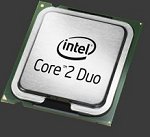HTPC Buying Guide: Processors

Let me start off by introducing our new article series here at Missing Remote. On a periodic basis, as technology moves on, we will be creating buying guides for each component of a HTPC. This is an effort of all editors here at Missing Remote with extra credit going to Matt for basically writing the guide. Of course, I need to get my two cents in there myself ;).
The brains of the operation: Today there is absolutely no reason to not go dual-core. Both AMD and Intel offer amazing deals on dual-core processors that run cool and thus can be run quietly, which are both keys to a good HTPC. Which platform you choose is mostly preference and budget. AMD has incredible offerings for the budget range; however the Intel Core 2 Duo architecture is now easily out performing the AMD Athlon X2 family.
Some notes about power consumption
Both AMD and Intel’s stock CPUs are 65 watt typical power consumption parts, so this means you can feel free to pick most low to mid range CPUs from both vendors and you’ll be doing fine. High end CPUs are another matter, the high end AMD and Intel CPUs go up to 125 watt power consumption, you don’t want these hot running fellows, nor are they necessary. For AMD the cutoff point is the Athlon X2 5200+ and for Intel the cut off is the Core 2 Duo E6700.
Want ultra low power consumption and thus even lower heat? AMD has their new “BE” line of Athlon X2’s, these suckers run on a sip of power at only 45 watts. You do pay a $25 premium for it over the comparable 65 watt part, but it may be worth it, especially in a smaller HTPC chassis. The BE-2400 ($110) is equivalent to the standard 4400+ ($85).
Tip: In case you want to check out specs of various levels of AMD CPUs, AMD has a great website setup for you to do so; it lists the typical power consumption of the CPU, voltages, and all other critical stats for a processor. You can filter the list by power consumption so you know what CPUs are available. Find it at www.amdcompare.com.
What do I need?
Really just about any modern dual core CPU will do for HTPC tasks. Some outstanding values include the Core 2 Duo E4x00 series and the Athlon X2 4200+ to 4800+ range.
If you aren’t too concerned with heavy video encoding or working with lots of HD material you may want to consider Intel’s newest budget CPU the Pentium Dual-Core E2140 or E2160 which run around $75 to $80. Despite the use of the name “Pentium” these are indeed derived from the Core 2 Duo; however these are made to occupy the budget segment of the market by dropping the bus speed to 800 MHz and cutting the cache back to only 1MB. Since these are cousins to the Core 2 Duo they use the same Socket 775 motherboards as their fully featured relatives, so you have an upgrade path if you want more power later.
Speciality Needs
The above part of the guide really covers your general usage patterns of PVR/Media Library/DVD Library type duties. There are a few specific cases where a bit more horsepower such as the budget quad core CPU from Intel maybe needed.
Often a HTPC is asked to handle a number of tasks at any given moment such as commercial skip processing, gaming, general media server duties and video encoding. Such an environment is pretty common and may require a bit more CPU to keep things running. In this case, Intel’s Core 2 Quad Q6600 may be a better CPU for those needs, it is a very good value at $280. Just be sure to plan for the hotter CPU, the Q6600 consumes 105 watts versus the 65 watts of the Core 2 Duo processors. Everything should stay smooth and you won’t have to worry about your shows skipping while playing a game of Unreal Tourney.
If you are going to go the next gen DVD route, be sure you have a healthy dual core CPU mentioned above paired with the right video card. However, if you plan on using one of the onboard video solutions or a video card that doesn’t offer MPEG4-AVC (H.264) hardware acceleration be sure to get at least an AMD Athlon X2 4800+ or equivalent Intel Core 2 Duo. More info can be found by reading Matt’s guide on adding Blu-ray or HD DVD to your system.
